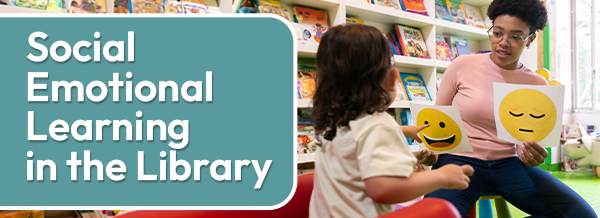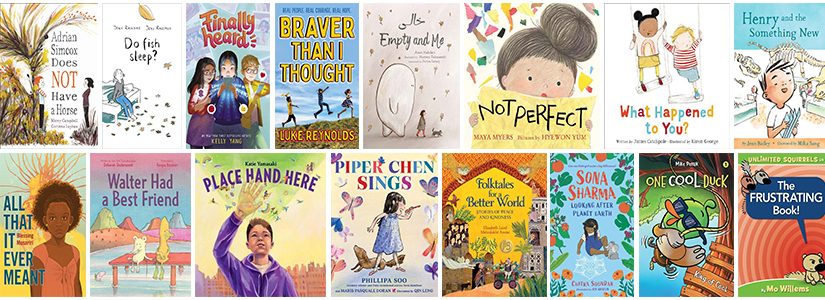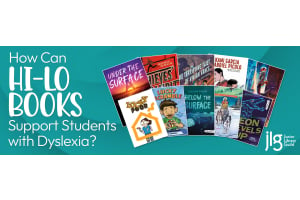Social Emotional Learning in the Library


Young students are facing a national mental health crisis, and to help combat these struggles, social and emotional learning (SEL) standards are being implemented in schools. According to the Collaborative for Academic, Social, and Emotional Learning (CASEL), SEL covers a broad spectrum of important knowledge and developmental skills including:
- Acquiring and applying the knowledge, skills, and attitudes needed to develop healthy identities
- Managing emotions and achieving personal and collective goals
- Feeling and showing empathy for others
- Establishing and maintaining supportive relationships
- Making responsible and caring decisions
Helping students develop these lifelong skills is a momentous task, but don’t fear—JLG is here to support you and your library! In this blog post, we’ll explore how libraries can cultivate SEL skills by encouraging readers’ self-discovery, creating a safe space for communication, and stocking your collection with titles that have positive messages and spark thoughtful discussions around topics like ethics, kindness, and relationships. You’ll even learn more about our Character Building Category, which was practically built for SEL development! If you have questions about JLG’s in-stock SEL titles, you can send our curation specialists an inquiry here.
Promoting Growth and Self-Discovery
With the help of thoughtful library programming, students can learn more about their emotions, behaviors, and interests. One way to incorporate SEL programming in your library is by practicing Yoga Storytime! In an article from School Library Journal titled “Strike a Pose: Yoga for Young People, from Babies to Teens”, librarians share their successes with this physical programming, noting that it helped people of all ages stay active and practice mindfulness. Leigh Ramey, a youth services consultant for the South Carolina State Library said, “Little children don’t have the ability yet to voice that they’re frustrated or tired… Yoga programs give us an opportunity to teach children to self-regulate. It’s another level of support we can offer at the library.” Libraries not only help students learn about the world around them, but also promote self-awareness and discovery, which are great tools for personal growth.
Making Libraries a Safe Space
The American Library Association has multiple committees working to make libraries safe spaces by developing, providing, and disseminating “materials and programming for libraries that deter hate, foster community, and oppose bigotry toward or oppression against any group.” (ALA) Plus, there are numerous librarians taking creative approaches to making sure readers feel welcome in their library—like letting students wear earbuds!
In a Publisher’s Weekly article titled “Literacy Focus: Welcoming Places, Safe Spaces”, James Klise—a teacher librarian and an Edgar and Stonewall Honor Award-winning YA author—talks more about how his earbud policy increases comfort and conversations in his school library:
“‘The students recognize that if I care about the little things, I care about the big things, too,’ he said. ‘By meeting this and other expectations, they feel successful and safe, which then allows them to do all the things they want to in the library, including getting work done and exploring anything that interests them in terms of career, creatively or even personally.’
In turn, these positive feelings and actions increase the level of comfort in the library space and offer ample opportunities for conversations about research projects and writing projects (one of Klise’s secrets to learning students’ names), and lively discussions about books.”
It’s undeniable: cultivating an emotionally secure space for readers will encourage them to learn, share their learnings with others, and develop confidence.
Diversifying and Adding to Your Collection
Literature offers readers a wide lens of new perspectives, encouraging students to think big and explore themes further from home—all from the safety of a page! Stories that depict diverse cultures, ideas, and life experiences prompt readers to put themselves in someone else’s shoes or practice SEL skills like empathy. In our past blog post, How Does Reading Improve Your Mental Health?, we discuss a study where high school students read and responded to stories that embodied positive themes, which lead to an improvement in the students’ “mindfulness, optimism, happiness, and overall positive emotions, and caused reduction in depression, anxiety, pessimism, and other negative emotions”. This study proves the powerful effects that literature has on students’ overall wellbeing and development and demonstrates how they can use these important skills both inside and outside the classroom or library.
It is crucial that libraries offer accessible literature that embodies SEL practices and inspires readers to dig deeper, and that is why JLG takes pride in offering books for every reading level with these themes and messages. For elementary readers especially—who are constantly absorbing information and building their identities—our Character Building Category is the perfect fit, featuring recent award-winning titles like BIG by Vashti Harrison and A Walk in the Woods by Nikki Grimes. Similarly, JLG’s Multicultural Elementary and City Elementary categories offer titles with diversity, new perspectives, and positive messages for young readers.
Conclusion
Helping readers and students’ development SEL skills in your library is no small feat. We recognize the pivotal role that librarians play in holistically supporting our next generation of learners and we want to extend our gratitude for all that you do: thank you. Let’s make a positive impact on students—together—and help them continue growing and reading with the BEST books at their disposal. If JLG can help support your library, or offer suggestions on SEL Gold Standard Selections, please reach out to us here.
JLG Social Emotional Learning Titles











